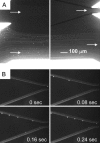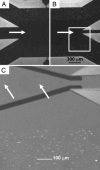Marker-specific sorting of rare cells using dielectrophoresis
- PMID: 16236724
- PMCID: PMC1276091
- DOI: 10.1073/pnas.0507719102
Marker-specific sorting of rare cells using dielectrophoresis
Abstract
Current techniques in high-speed cell sorting are limited by the inherent coupling among three competing parameters of performance: throughput, purity, and rare cell recovery. Microfluidics provides an alternate strategy to decouple these parameters through the use of arrayed devices that operate in parallel. To efficiently isolate rare cells from complex mixtures, an electrokinetic sorting methodology was developed that exploits dielectrophoresis (DEP) in microfluidic channels. In this approach, the dielectrophoretic amplitude response of rare target cells is modulated by labeling cells with particles that differ in polarization response. Cell mixtures were interrogated in the DEP-activated cell sorter in a continuous-flow manner, wherein the electric fields were engineered to achieve efficient separation between the dielectrophoretically labeled and unlabeled cells. To demonstrate the efficiency of marker-specific cell separation, DEP-activated cell sorting (DACS) was applied for affinity-based enrichment of rare bacteria expressing a specific surface marker from an excess of nontarget bacteria that do not express this marker. Rare target cells were enriched by >200-fold in a single round of sorting at a single-channel throughput of 10,000 cells per second. DACS offers the potential for automated, surface marker-specific cell sorting in a disposable format that is capable of simultaneously achieving high throughput, purity, and rare cell recovery.
Figures




References
-
- Gee, A. P. & Durett, A. G. (2002) Cytotherapy 4, 91-92. - PubMed
-
- Thiel, A., Scheffold, A. & Radbruch, A. (1998) Immunotechnology 4, 89-96. - PubMed
-
- Wachtel, S. S., Shulman, L. P. & Sammons, D. (2001) Clin. Genet. 59, 74-79. - PubMed
-
- Miltenyi, S., Muller, W., Weichel, W. & Radbruch, A. (1990) Cytometry 11, 231-238. - PubMed
-
- Chalmers, J. J., Zborowski, M., Sun, L. P. & Moore, L. (1998) Biotechnol. Progr. 14, 141-148. - PubMed
Publication types
MeSH terms
Substances
LinkOut - more resources
Full Text Sources
Other Literature Sources

